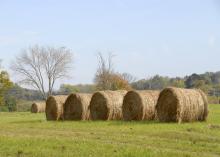Information Possibly Outdated
The information presented on this page was originally released on October 26, 2012. It may not be outdated, but please search our site for more current information. If you plan to quote or reference this information in a publication, please check with the Extension specialist or author before proceeding.
State's growers make hay while the sun shines
MISSISSIPPI STATE – Mississippi’s hay producers increased acreage and yields this season in spite of variable rainfall across the state.
“Hay production systems in the central part of the state had a really good season,” said Rocky Lemus, Mississippi State University Extension Service forage specialist. “We’ve been blessed with quite a bit of rain in central Mississippi, and the hay crop has been better than average.
“On the other hand, in the northern region and southwestern corner of the state, we’re under severe drought conditions, so the hay production systems in those areas are on the fair side,” he said.
John Michael Riley, agricultural economist with MSU’s Extension Service, said current reports put Mississippi hay production at 750,000 acres, up from 720,000 acres in 2011. If yields are consistent with the state’s average of 2.42 tons per acre, the state’s 2012 hay production would be 1.82 million tons. This is an increase over the 1.73 million tons produced in 2011.
“Currently, reported prices translate to about $45 to $55 per ton,” Riley said.
The season average price will likely be higher, about $80 per ton, which would put hay’s value at $145.2 million for the year, he said.
“Hay has the potential to be the fourth most valuable crop in Mississippi, behind soybeans, corn and cotton,” Riley said.
Louis Breaux of Breaux Services has 600 acres under cultivation in Hancock County. He said rain was both a blessing and a curse.
“The low point of the season was when Hurricane Isaac dumped 20 inches of rain on the coastal counties,” Breaux said. “Weeds were taking over, army worms came in and we needed to do extra spraying, but you can’t spray while it’s raining. Then, rain in September put us back a bit on harvesting.”
Breaux said rain helped producers get through October’s typical dry spell and kept the soil moist for planting fall grasses.
“The high point of the season was that we got the moisture we’ve lacked the past two to three years,” he said. “Growers in Hancock and Harrison counties planted their first round of grass a week to 10 days ago, and it’s already coming up.”
Lemus said good weather conditions have allowed producers to plant their rye grass and winter forages ahead of schedule.
“About 90 percent of the winter crops have been planted, and some of them have already germinated two weeks ahead of schedule for what we usually see around the state,” he said.
Lemus, who is also a researcher with the Mississippi Agricultural and Forestry Experiment Station, said weather contributed to the season’s pest and disease pressures.
“We’ve seen an increase in army worms because of 2011’s very warm winter,” he said. “Usually we depend on cold weather to reduce their populations, but we didn’t get that chance last year. The extended warmer weather also led to an increase in grasshopper populations.”
Bermudagrass especially suffered from increased disease pressures, including stem maggot and gray leaf spot disease.
“We’ve also seen an increase in Take-all root disease, because dry conditions and poor fertility in pastures allows this disease to be more prolific,” Lemus said.
Despite these challenges, Lemus saw a 70 percent increase in the number of growers interested in selling hay through the Mississippi Hay Directory. The directory is a listing maintained by Lemus designed to connect livestock producers with hay suppliers.
“People have hay to sell, and they may sell out of state to the Midwest, Arkansas and Missouri where there is a need,” Lemus said. “Producers need to be aware of restrictions related to the fire ant quarantine. They need to contact the Mississippi Bureau of Plant Industry to set an appointment with an inspector to get the hay certified before it is shipped to counties in other states where there is a quarantine in place.”
More information on the fire ant quarantine and hay inspection process can be found in Extension publicaiton P2733, “Imported Fire Ant-Free Hay Certification in Mississippi.”





